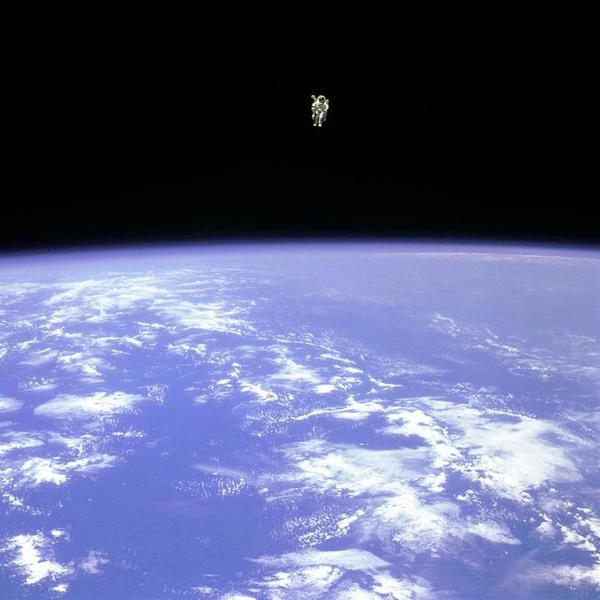
Image description: The first free flight of an astronaut in space dates back to 1984. Astronaut Bruce McCandless is the first man to move freely using an MMU (Manned Maneuvering Unit), propelled by nitrogen jets. One can easily imagine the anxiety a man might feel flying at 27,700 km/h in this state of weightlessness, with our planet as the horizon.
Since its first launch in 1998, up to 9 astronauts permanently occupy the International Space Station (ISS). Confined in their solitude, shielded from solar rays, astronauts paradoxically see the immense space surrounding Earth, while they themselves are kept in a considerably restricted space.
Astronauts travel at a speed of 7.7 km/s in low Earth orbit and scan the vast terrestrial regions that pass "under" the station. They witness about 16 sunrises and sunsets every day. But it is "down" in the night that they see their only horizon, Earth. The night spectacle offers them red and green auroras, as well as the lights of major terrestrial cities with a backdrop of multicolored stars. Earth's atmosphere reflects solar rays.
N.B.:
Weightlessness or zero gravity? The term zero gravity is used in everyday language, but today the term weightlessness is preferred. Weightlessness is a theoretical state because it does not exist in the Universe; there is always some residual gravity, no matter where in the cosmos. On board a spacecraft, microgravity is generally referred to. Microgravity has a value on the order of one-millionth of Earth's gravity.
The International Space Station (ISS) is very close to Earth and is clearly visible at night because it reflects sunlight, especially thanks to its immense solar panels.
When it flies over your region, you can spot it without special equipment. However, due to its high speed, it is not always easy to know when and where to observe it. The "ISS Live Now" application indicates in real-time where the Space Station is; it orbits Earth at about 415 km altitude at a speed of ≈7.7 km/s.
This tool allows you to track its position in real-time. Once you know when and where it will pass, wait for dawn or dusk. The Space Station looks like a large bright star crossing the sky, moving about one degree (twice the diameter of the Moon) every second. The ISS arrives from the West.